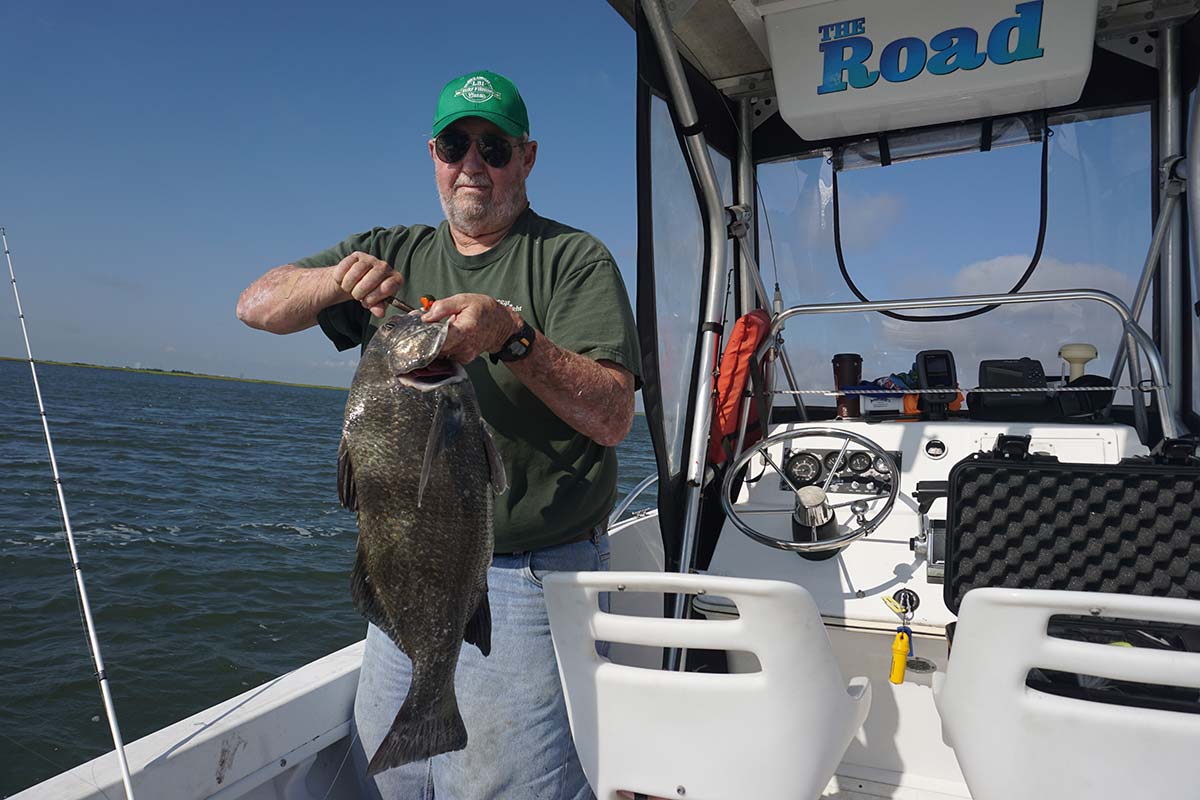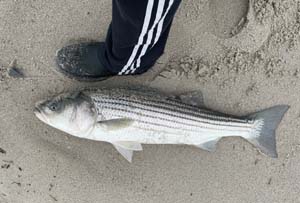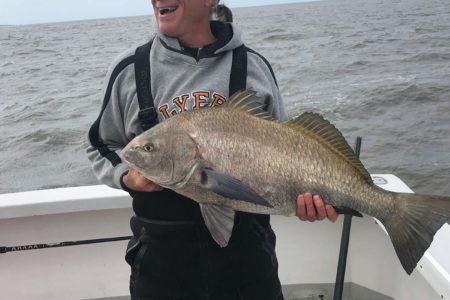
And the beat goes on…
If you didn’t hear all the hubbub this past April, a battalion of black drum invaded Barnegat Bay waters during the April new moon spawn, offering big game battles for pier and shorebound anglers who got bent with fish up to 60 pounds.
Historically, the full and new moons in April, May and June are prime spawning times for the boomers and with a new moon passing on June 6 black drum will be on the chew in New Jersey and Delaware in spots like Great Bay and Brigantine as they move in to finish up their spawning season.
We could very well see an invasion of the big-shouldered brawlers in the back bays, though the main body of fish can still be found on the Delaware Bay, the main spawning ground in the world for black drum.
Here’s how to bang on a few drums this June.

Spot Hop
Generally, boomers will follow channels that are cut into flats-related areas, moving along with the tides and currents to feed upon mussels and clams that get funneled through the underwater superhighway. Shallow bay backwaters in South Jersey that perennially attract parts of the spawning schools are areas such as Holgate, Wreck Inlet, Brigantine, behind LBI in Barnegat Bay and Great Bay. In the Delaware Bay, old school drum haunts include the Pin Top, Horseshoe, 60 Foot Slough, 20 Foot Slough and the C&B on the Jersey side and Slaughter Beach on the Delaware side of the bay.
| DID YOU KNOW? |
| The New Jersey state record black drum of 109 pounds was caught in Delaware Bay by Nick Henry in 2008. The IGFA all-tackle world record stands at 113 pounds, 1 ounce and was also caught inside the D-Bay back in 1975 by Gerald Townsend. |
Regardless of where you choose to set up, plan your drum outings around the full and new moon tides as the highest waters bring the fish in to spawn more effectively. Generally the three days leading up to and after the full or new moon in June are prime times. Though fishing via boat is the best way to get a bite going, there are many options to fish from piers, docks and the surf to tangle with a boomer, namely areas like Holgate beach, Brigantine Beach and the Absecon Inlet rocks.
Rods and reels need to be pretty beefy as the barrel-chested brutes can really use their weight to their advantage. In the old days, Penn Tuna Sticks were the standard, but you can go with Shimano Tallus (TLC66MHBBL) rods matched with Shimano TLD 25 reels, spooled with 65-pound braided Power Pro line. Rigs are of the fishfinder variety, meaning a sliding sinker clip with 3- to 6-ounce bank sinker, a 150-pound Spro barrel swivel, 36-inch section of 80-pound Seaguar fluorocarbon leader and a size 10/0 Gamakatsu Octopus Circle hook on the business end.
Bait up with big ol’ surf turkey gobs of fresh clam, loading up the hook, but be sure to pierce the point out so it can find its purchase on a hookset. If fishing from the surf or a back bay pier, go with a spinning outfit such as a Penn Battle III 10000 reel and 10- to 11-foot Shimano Tiralejo surf rod in order to be able to launch baits out into the zone. Just be sure to keep an eye on those sand spikes and keep the drags a bit loose as many a rod has been claimed into the sea by aggressive drum hitting and running off.

Chum & Fight
Once you’ve found your hot spot along a channel edge or a flat, anchor up and get ready for battle. Before you do anything, start chumming with clam and mussel logs. Drum can be trained like big old bloodhound dogs and if you get a good trail scent going, they’ll follow it right in. Fresh clams or mussels are the primo baits to attract the broomtailed battlers, and any trip out should start by sending down two chumpots off the bow filled with fresh clams and clam juice up.
When a black drum takes the bait, the clicker goes off and makes that heart-stopping sound. Don’t set the hook just yet; drum notoriously sniff around and mouth baits for a few moments before getting the thing down their throat. Sometimes the drum will even play with the bait for a little bit, continually peeling off little sections of line but not committing. Let them run with it until it’s a steady pull five- to seven-count; then simply engage the reel and the circle hook will do its job.
| BOOK A TRIP |
| The Delaware Bay drum fleet typically books up well in advance of the May fishery, but if you’re looking to score you can get intel, boat recommendations and fresh clam and rigs by checking in with the folks at Hands Too Bait And Tackle (609-884-2248) on the north side of the Highway 109 Bridge over the Cape May Canal. Several boats also run out of Fortescue in Downe Township, Cumberland County; for information try Higbee’s Bait and Tackle (856-447-4157) just across the bridge when you head into town.
In Delaware, try checking with the folks at Lewes Harbour Marina fishing center (302-645-6227) for charter boats and advice; the marina is located at 217 Anglers Road in Lewes. You can also visit Smith Bait at 500 Denny Street in Leipsic, DE or call them for drumming advice at (302-744-9140). |
Black drum are night owls by nature. Though they can be taken during morning and daytime hours, the best time to hear the drum go boom is from 5 p.m. onward into sunset – and it doesn’t stop there. As soon as the stars come out, drum tend to get even friskier and the bite lasts solid and strong usually up until the midnight hour.
In the 90’s and early 2000’s catching a handful of huge boomers pushing the 80- to 90-pound mark were relatively commonplace on a night drum trip, but invariably the stocks took a bit of a hit as anglers would stack them on the docks. It’s taken awhile to get them back on track in Delaware Bay, so let’s not repeat the past. The larger black drum are not known as a good eating fish, especially ones over 20 to 30 pounds, and there really is no need to keep the bigger ones, though of course you can legally and if you have a hankering for the taste. My advice is to release any big drum you catch, as it’s much better to see the big Clydesdales swim away to procreate and keep a fun fishery going strong.
Big boomer drum can really put up a tussle and behemoths that push the 90-pound mark are not uncommon in Delaware Bay, with average sizes in the 40- to 80-pound range. If you’ve never buckled down on a big boomer, give it a shot this June.
Enjoy the battle!





